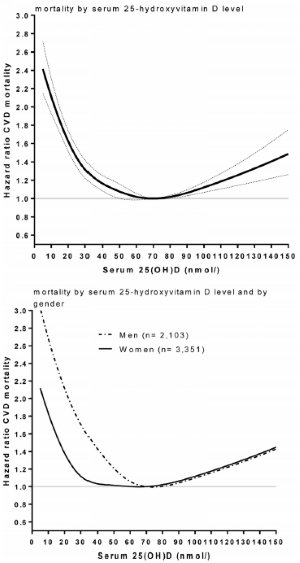CONTEXT:
Cardiovascular disease is the major cause of death in the Western world, but the association between 25-hydroxyvitamin D [25(OH)D] levels and the risk of cardiovascular disease mortality remains unclear.
OBJECTIVE:
The objective of the study was to determine the association between cardiovascular, stroke, and acute myocardial infarct mortality and serum levels of 25(OH)D.
DESIGN:
This was an observational cohort study, the Copenhagen vitamin D study, data from a single laboratory center in Copenhagen, Denmark. Follow-up was from 2004 to 2011.
SETTING:
Serum 25(OH)D was analyzed from 247 574 subjects from the Copenhagen general practice sector.
PARTICIPANTS:
Examination of the association 25(OH)D levels and mortality from cardiovascular disease, stroke, and acute myocardial infarct was performed among 161 428 women and 86 146 men.
MAIN OUTCOME MEASURES:
A multivariate Cox regression analysis was used to compute hazard ratios for cardiovascular, stroke, and acute myocardial infarct mortality.
RESULTS:
Of 247 574 subjects, a total of 16 645 subjects died in the ensuing 0-7 years. A total of 5454 died from cardiovascular disease including 1574 from stroke and 702 from acute myocardial infarct. The 25(OH)D level of 70 nmol/L was associated with the lowest cardiovascular disease mortality risk. Compared with that level, the hazard ratio for cardiovascular disease mortality was 2.0 [95% confidence interval (CI) 1.8-2.1] at the lower extreme (∼ 12.5 nmol/L) with a higher risk for men [2.5 (95% CI 2.2-2.9)] than for women [1.7 (95% CI 1.5-1.9)]. At the higher extreme (∼ 125 nmol/L), the hazard ratio of cardiovascular disease mortality was 1.3 (95% CI 1.2-1.4), with a similar risk among men and women. Results were similar for stroke and acute myocardial subgroups.
CONCLUSIONS:
In this large observational study, low and high levels of 25(OH)D were associated with cardiovascular disease, stroke, and acute myocardial mortality in a nonlinear, reverse J-shaped manner, with the highest risk at lower levels. Whether this was a causal or associational finding cannot be determined from our data. There is a need for randomized clinical trials that include information on the effects of 25(OH)D levels greater than 100 nmol/L.
